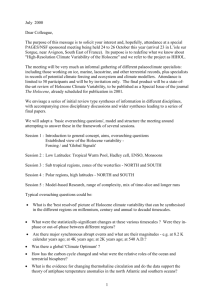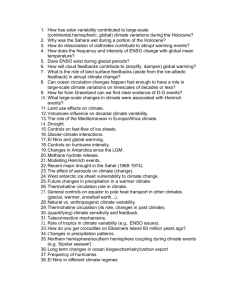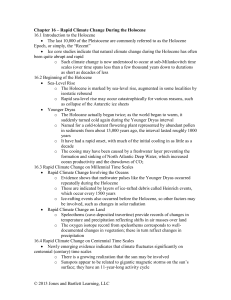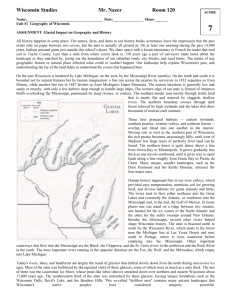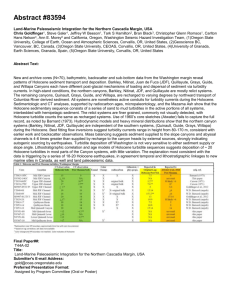Instructions for Quaternary Faunal Environments
advertisement
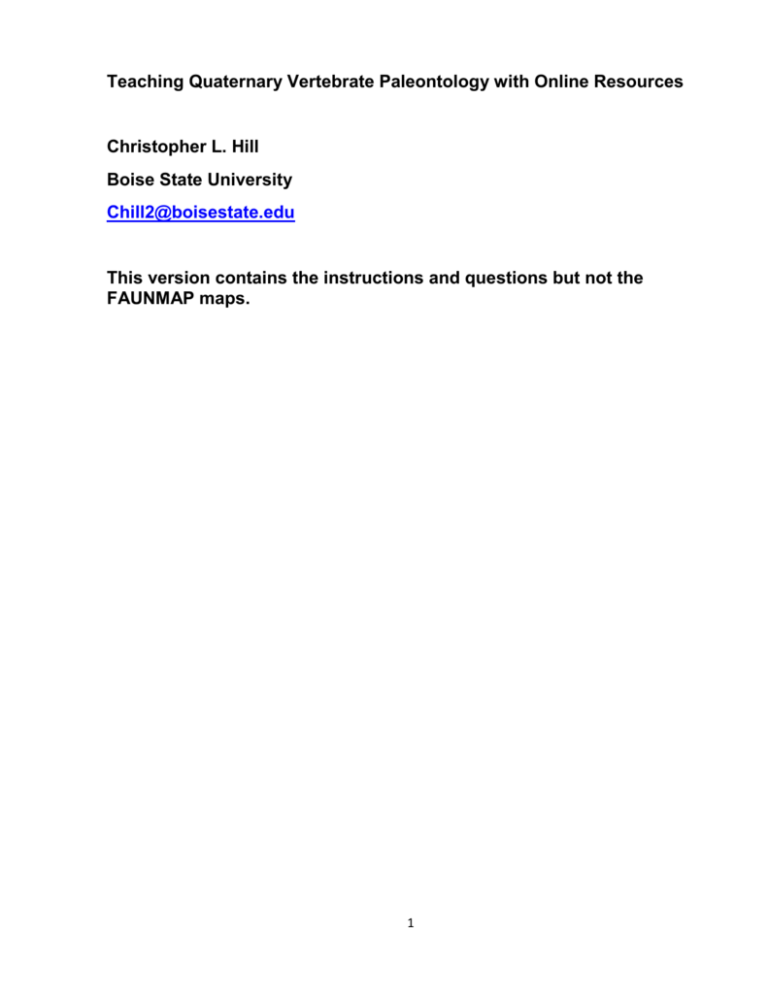
Teaching Quaternary Vertebrate Paleontology with Online Resources Christopher L. Hill Boise State University Chill2@boisestate.edu This version contains the instructions and questions but not the FAUNMAP maps. 1 Faunal Environments – Late Quaternary Mammals Spatial and Temporal Patterns. Quaternary Vertebrate Paleontology One of the most important uses of paleontological data is understanding past environments and the processes that have led to present-day biotic patterns. The goal of this exercise is to explore what kinds of information can be inferred about environments using small and large mammals. You will generate hypotheses regarding past environments based on comparing the present-day and past distributions of extinct and extant mammals. In addition, you will gain some experience in using online databases to evaluate environmental change over time. This assignment consists of three parts: 1) Research the kinds of environments which the animals listed in the table below inhabit, for the extant (non-extinct) under natural (“wild”) conditions. What are the habitats and biomes associated with the animals? How do they compare (are they distinct, do they overlap, etc.). Cite your sources! 2) Use the FAUNMAP online program (http://www.museum.state.il.us/research/faunmap/query/) to study the spatial distribution of these animals during different time intervals in the late Quaternary (answer the questions below using FAUNMAP). 3) Use your answers to guide you interpret these patterns in light of what you learned about the environments associated with these fauna. FAUNMAP provides distribution maps of mammal taxa (recorded fossil discoveries) by time categories. The patterns of mammal taxa at various time intervals and geographic distributions are not uniform. What kinds of factors help to determine the distribution of mammal localities? Can you link the spatial distribution of each species with known climate events? Interpret the spatial distributions based on what you learned about the environments associated with each species. What conclusions can you make? What animals appear to restricted to certain environmental conditions? Write a detailed report that includes an evaluation of the environmental settings associated with the extant mammals, your inferences about the habitats associated with the extinct taxa. What kinds of patterns can you discern regarding the relationship between the spatial and temporal distributions of these mammals and environmental change? 2 Class Mammalia Order Didelphimorpha Order Xenartha Order Insectivora Order Carnivora Family Didelphidae Family Dasypodidae Family Megatheridae Family Mylondontidae Family Soricidae Family Canidae Family Felidae Family Mustelidae Order Proboscidea Order Perrissodactyla Order Artiodactyla Order Rodentia Order Lagomorpha Family Camelidae Family Cervidae Family Bovidae Family Antilocapridae Family Muridae Family Lepordae Species (* = extinct in North America) Opossum Armadillo Shasta groundsloth* Harlan's ground sloth* Arctic shrew Dire wolf*, gray wolf Cheetah*, saberooth cat*, lion* Black-footed ferret Columbian mammoth*, Jefferson's mammoth*, woolly mammoth*, mastodon* Horse (Mexican horse*) Yesterday's camel* Stag moose*, caribou Harlan's muskox*, muskox Pronghorn Eastern woodrat Pygmy rabbit, swamp rabbit This table shows the kinds of fauna you can use for this assignment. 3 Using FAUNMAP 1. This is what the first page at http://www.museum.state.il.us/research/faunmap/query/ looks like: Query the Database About this service Read This First! o o List of taxa codes List of age codes Faunmap Query Form (scientific names) Faunmap Query Form (common names) How does this work? (Really, how did it used to work) 2. Select : Faunmap Query Form (scientific names) or Faunmap Query Form (common names). 3. Choose your mammal: Faunmap Query Form This form should produce an on-the-fly map based on the Faunmap database. Depending on the question and traffic on our server, it may take 2-3 minutes or more of processing time before the result is sent back to you. PLEASE do not stop the process after you submit it--this sometimes leaves the Arc/Info process running on our server. Taxon: Antilocapra americana Arctocephalus tow nsendi Alces alces Ammospermophilus harrisii Ammospermophilus interpres Ammospermophilus leucurus Ammospermophilus nelsoni Antrozous pallidus If we have it for this taxon, do you want the modern distribution? Yes Submit No Erase 4. Pick the time periods you want to study (note: for some species not all time periods will be represented). 4 [wiho][wisc][lwsc][late][ehlg][holo][emho][mhol][lmho][lhol][hiho][hist][ALL] Do you want to list these sites? Back to FaunMap page [wiho][wisc][lwsc][late][ehlg][holo][emho][mhol][lmho][lhol][hiho][hist][ALL] Here is a list of age codes: List of Faunmap age codes Evaluation of, and decisions about assignment of an Analysis Unit to an age class are not always straightforward. The files served here use the "Research Ages" (RESAGE) as defined on pp.24-25 of the Faunmap hardcopy. If an Analysis Unit was predominantly incorporated in one RESAGE category but overlapped slightly with another, it was necessary to decide whether it should be assigned to the predominant category or whether it should be lumped with both categories. For example, if an Analysis Unit had minimum and maximum ages of 2100 years B.P. and 4300 years B.P, respectively, it was predominantly in the Late Holocene but overlapped slightly with the Middle Holocene. To resolve 5 these issues, it was decided that if the overlap was less than 500 years, then the Analysis Unit would be assigned to the predominant category (e.g., Late Holocene, in this case). If the overlap was greater than 500 years, then the Analysis Unit was referred to a combined time category (E.G., Late/Middle Holocene). For the boundary between the Post-Columbian and Late Holocene, an overlap of 50 years was used. Some things to note: Each analysis unit is assigned to one and only one time unit. A locality may contain any number of analysis units, and any number of time periods. In the files searched here, there is a single record per taxon, per age category, per locality. The age categories are mutually exclusive: searching for LMHO will not give you the records of LHOL and MHOL, but only those records who could only be assigned to LMHO. For more detailed searching, you will have to download the database and move it into your own database managment program. The search forms have the added ability to not reselect by age category--this is labeled "All Time Periods." Searching with this will give you all localities in the database with that taxon regardless of age. Finally, we have not included all of the age categories in the "pull-down" items. If you want to search for (for example) HIHO, use the query form for Lynx. Here are the codes and values used for assignment. HIST (Post-Columbian) 0-550 years B.P. LHOL (Late Holocene) 450-4500 years B.P. HIHO (Post-Columbian/Late Holocene) 0-4500 years B.P. MHOL (Middle Holocene) 3500-8500 years B.P. LMHO (Late Holocene/Middle Holocene) 0-8500 years B.P. EHOL (Early Holocene) 7500-10,500 years B.P. EMHO (Early Holocen/Middle Holocene) 3500-10,500 years B.P. LATE (Late Glacial) 9500-15,500 years B.P. EHLG (Early Holocene/Late Glacial) 7500-15,500 years B.P. FULL (Full Glacial) 14,500-20,500 years B.P. GLAC (Glacial) 9500-20,500 years B.P. HOLO (Holocene) 0-10,000 years B.P. WIHO (Holocene/Pleistocene) 0-110,000 years B.P. LWSC (Late Wisconsin) 20,000-40,000 years B.P. WISC (Wisconsin) 10,000-110,000 years B.P. You should review the connection between these time intervals and major changes in Late Quaternary envirionments. 6 Examining Late Quaternary Mammal Distributions Through Space and Time. In this project you will look at the distribution of a variety of taxa from the Late Quaternary using the online FAUNMAP database. 1. The opossum is an example of the Order Didelphimorphia. What kinds of environments are presently inhabited by this species? Use FAUNMAP to look at its modern distribution. Compare this to the distribution of Didelphis during the late Wisconsin (40,000-20,000 B.P.) and late Glacial (15,500-9,500 B.P.). Modern Late Wisconsin Late Glacial 2. Compare the spatial distribution of the extinct armadillo Dasypus bellus (Order Xenartha, Family Dasypodidae) for the late Wisconsin (40,000-10,000 B.P.) or all FAUNMAP localities to the present-day distribution of the opossum. Modern Opossum Extinct Armadillo 3. Another species of the Order Xenartha was the Shasta Ground Sloth (Nothrotheriops shastense, Family Megatheridae). Examine its combined Late Wisconsin, Glacial and Late Glacial distribution (FAUNMAP = ALL). Shasta Ground Sloth Localities 5. How does this distribution compare to the present-day distribution of Didelphis virginiana (the extant opossum) and Dasypus bellus (the extinct armadillo)? Ground sloth Opossum Extinct Armadillo What geographic areas are the various taxa restricted to? What might explain the distributions? 6. Another extinct ground sloth, Harlan’s ground sloth (Glossotherium harlani) is also known from the Quaternary. Examine its FAUNMAP distribution and compare it with Nothrotheriops. 7 Which taxon appears to be more restricted? What kinds of habitats might be associated with Glossotherium? How might the distribution of Glossotherium be connected with landscapes associated with glacial climates? 7. The Order Insectivora includes Sorex articus (Artic shrew, Family Soricidae). Compare the Late Wisconsin/Glacial distributions of Sorex arcticus with its present-day distribution. Is there any overlap? What might explain the distribution of this species of shrew during the last Ice Age? Modern Late Wisconsin Glacial 8. The Order Carnivora contains the felids, canids, and mustelids. These families contain extinct and extant forms (including some that are on the endangered species list). 8.a. Family Canidae. Compare the Late Wisconsin and all FAUNMAP localities for the distribution of Canis dirus (the extinct dire Wolf) and Canis lupus (the extant gray wolf). Canis dirus Canis lupus 8.b. Family Felidae. Examine the distributions of Miracinonyx trumani (American cheetah), Smilodon sp. (sabertooth cat) and Panthera leo atrox (American lion). Are any of these extinct taxa similar in distribution to the canids? Does the distribution of any of these felids coincide with the ground sloths? Cheetah Sabertooth Lion 8.c. Another group of the Carnivora is the mustelids. Examine the Late Wisconsin and modern distribution of Musetla nigripes (the Black-footed Ferret). This species is found in short or middle grasslands and eats mostly prarie dogs (Cynomys, Order Rodentia, Family Sciuridae). Based on these relationships 1) interpret the Late Wisconsin distribution of grasslands and 2) predict the spatial distribution of Cynomys. 8 Black Footed Ferret Blackfooted Prarie Dog 9. Order Probosidea. What does the distribution of mammoths and mastodons tell us? 9.a. First look at the mammoths. What are the distribution patterns for Mammuthus columbi, M. jeffersoni, and M. primigenius? Columbia Jeffersonian Woolly 9.b. Compare these distributions with Mammut americanum (Family Mammutidae). Mammut 9.c. Compare these distributions with the distributions for Carnivoria taxa? Can you propose any predator-prey relationships based on potentially shared environments? 10. Look at the distribution of the extinct horse, Equus conversidens (Order Perissodactyla (Family Equidae). Is it more similar to Mammuthus columbi or Mammut? Equus 11. Examine the distribution for Camelops hesternus (Order Artiodactyla. Family Cameilidae). What probosidean would you expect to find in the environments inhabited by C. hesternus? Are there any predator-prey relationships that can be inferred? Camelops 12. The Family Cervidae contains extinct and living species. 12.a. What is the geographic location of Cervalces? Are there any other mammals that you have previously examined that have a similar geographic distribution? Stag Moose (Cervalces scotti) 9 Stag Moose Distribution 12.b. Look at the distribution patterns for two species of Odocoileus (mule deer and whitetailed deer) and Rangifer. Do any of these patterns appear to suggest environmental change? Odocoileus heminous (mule deer) O. virginianus (white-tailed deer) Rangifer tarandus (caribou) ALL (Pleistocene and late Holocene) and only late Holocene 13. Another taxonx in the Order Artiodactyla is the pronghorn (Family Antilocapridae, Antilocapra americana). Compare its spatial distribution during the Wisconsin and Late Glacial with the canids and the felids. Is there any pattern that might suggest a predatorprey relationship? Pronghorn Pronghorn Cheetah 14. The Order Artiodactyla also contains the Family Bovidae. Examine the present southern boundary and past distribution of Ovibos moschatus and distribution of Bootherium bombifrons. Where are muskox today compared to in the past? What might this mean about environmental conditions in the past? Ovibos Bootherium 15. Compare the distribution of bighorn sheep (Ovis canadensis, Order Artiodactyla. Family Bovidae) to the patterns of the muskoxen. To they show similar types of changes over time? Distribution of Bighorn Sheep in the past and present day. 10 16. Have there been any changes in the distribution of Yellowbellied marmots (Order Rodentia, Family Sciurdae, Marmota flaviventris) or the Eastern Woodrat (Neotoma floridana) during the Quaternary? Late Wisconsin Late Glacial Order Rodentia, Family Muridae, Eastern Woodrat (Neotoma floridana) Late Glacial 17. Look at the distribution of the swamp rabbit and the pygmy rabbit (Order Lagomorpha, Family Leporidae). 17a. Where is the Swamp Rabbit (Sylvilagus aquatis) situated today? 17b. Where is Pygmy rabbit (Sylvilagus idahoensis = Bracylagus idahoensis) situated today? 11 Swamp Rabbit Pygmy Rabbit Wisconsin locations compared to modern distributions. 17. c. Would either of these taxa be good choices for inferring environmental conditions of the past? Explain your answer based on what you have learned from this FAUNMAP exercise. 12
